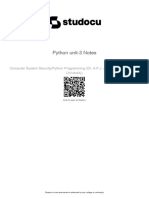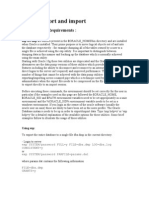0 ratings0% found this document useful (0 votes)
141 viewsPython Functions Exercise
The document contains 7 exercises to practice Python functions:
1. Create a function that takes name and age and prints them.
2. Create a function that accepts a variable number of arguments and prints them.
3. Create a function that returns multiple values - addition and subtraction of inputs.
4. Create a function with a default argument so it can be called with or without that argument.
5. Create nested functions - an inner function inside an outer function to calculate addition.
6. Create a recursive function to calculate the sum from 0 to a given number.
7. Assign a new name to an existing function and call it using the new
Uploaded by
Mateo HysaCopyright
© © All Rights Reserved
We take content rights seriously. If you suspect this is your content, claim it here.
Available Formats
Download as DOCX, PDF, TXT or read online on Scribd
0 ratings0% found this document useful (0 votes)
141 viewsPython Functions Exercise
The document contains 7 exercises to practice Python functions:
1. Create a function that takes name and age and prints them.
2. Create a function that accepts a variable number of arguments and prints them.
3. Create a function that returns multiple values - addition and subtraction of inputs.
4. Create a function with a default argument so it can be called with or without that argument.
5. Create nested functions - an inner function inside an outer function to calculate addition.
6. Create a recursive function to calculate the sum from 0 to a given number.
7. Assign a new name to an existing function and call it using the new
Uploaded by
Mateo HysaCopyright
© © All Rights Reserved
We take content rights seriously. If you suspect this is your content, claim it here.
Available Formats
Download as DOCX, PDF, TXT or read online on Scribd
You are on page 1/ 2
Python Functions Exercise Write a program to create function
calculation() such that it can accept two
variables and calculate addition and subtraction. Also, it must return both addition
and subtraction in a single return call.
Exercise 1: Create a function in Python
Exercise 4: Create a function with default argument
Write a program to create a function that takes two arguments, name and age, and
print their value. Write a program to create a function show_employee() using the following
conditions.
Exercise 2: Create a function with variable length of arguments
It should accept the employee’s name and salary and display both.
Write a program to create function func1() to accept a variable length of arguments
and print their value. If the salary is missing in the function call then assign default value 9000
to salary
Note: Create a function in such a way that we can pass any number of arguments
to this function and the function should process them and display each argument’s Exercise 5: Create an inner function to calculate the addition in the following way
value.
Create an outer function that will accept two parameters, a and b
Function call:
Create an inner function inside an outer function that will calculate the addition of
# call function with 3 arguments a and b
func1(20, 40, 60) At last, an outer function will add 5 into addition and return it
# call function with 2 arguments Exercise 6: Create a recursive function
func1(80, 100) Write a program to create a recursive function to calculate the sum of
numbers from 0 to 10.
Expected Output:
A recursive function is a function that calls itself, again and again.
Printing values
Expected Output:
20
55
40
Exercise 7: Assign a different name to function and call it through the new name
60
Below is the function display_student(name, age). Assign a new
Printing values
name show_tudent(name, age) to it and call it using the new name.
80
100
Exercise 3: Return multiple values from a function
Solutions show_employee("Ben", 12000) display_student("Emma", 26)
Exercise 1 show_employee("Jessa") showStudent = display_student
def demo(name, age): Exercise 5 showStudent("Emma", 26)
print(name, age) def outer_fun(a, b):
demo("Ben", 25) square = a ** 2
Exercise 2 def addition(a, b):
def func1(*args): return a + b
for i in args: add = addition(a, b)
print(i) # add 5 to the result
return add + 5
func1(20, 40, 60) result = outer_fun(5, 10)
func1(80, 100) print(result)
Exercise 3 Exercise 6
def calculation(a, b): def addition(num):
addition = a + b if num:
subtraction = a - b return num + addition(num - 1)
return addition, subtraction else:
res = calculation(40, 10) return 0
print(res) res = addition(10)
Exercise 4 print(res)
def show_employee(name, salary=9000): Exercise 7
print("Name:", name, "salary:", salary) def display_student(name, age):
print(name, age)
You might also like
- Working With Functions Xii Output Questions50% (2)Working With Functions Xii Output Questions7 pages
- Chapter-3 Functions Exercise Notes 2025-26No ratings yetChapter-3 Functions Exercise Notes 2025-264 pages
- FALLSEM2024-25_BCSE101E_ELA_VL2024250107585_2024-10-05_Reference-Material-INo ratings yetFALLSEM2024-25_BCSE101E_ELA_VL2024250107585_2024-10-05_Reference-Material-I57 pages
- Python Advanced Programming: The Guide to Learn Python Programming. Reference with Exercises and Samples About Dynamical Programming, Multithreading, Multiprocessing, Debugging, Testing and MoreFrom EverandPython Advanced Programming: The Guide to Learn Python Programming. Reference with Exercises and Samples About Dynamical Programming, Multithreading, Multiprocessing, Debugging, Testing and MoreNo ratings yet
- 07-08-2023 -the hindu Hand Written NotesNo ratings yet07-08-2023 -the hindu Hand Written Notes14 pages
- The Data Leader's Guide To Modern Analytics100% (1)The Data Leader's Guide To Modern Analytics30 pages
- Trends and Challenges in Soc VerificationNo ratings yetTrends and Challenges in Soc Verification22 pages
- Chapter 17 Linked Lists: Starting Out With C++, 3 EditionNo ratings yetChapter 17 Linked Lists: Starting Out With C++, 3 Edition68 pages
- EG8040F5 Datasheet 01: Intelligent Routing-Type ONT Date: 2019-08-01No ratings yetEG8040F5 Datasheet 01: Intelligent Routing-Type ONT Date: 2019-08-013 pages
- Teleca - OSS For Network Operators - Mentions Service Robots - Apr02No ratings yetTeleca - OSS For Network Operators - Mentions Service Robots - Apr0252 pages
- Im Improving Memory Proving Space Utilization in Multi-Core Embedded Systems Using Task RecomputationNo ratings yetIm Improving Memory Proving Space Utilization in Multi-Core Embedded Systems Using Task Recomputation9 pages
- Work Experience: 201 Wood St. BA 11 Pittsburgh, Pennsylvania 15222No ratings yetWork Experience: 201 Wood St. BA 11 Pittsburgh, Pennsylvania 152222 pages
- CHP192 - ITT600 Explorer For IEC61850 Systems - Operation & MaintenanceNo ratings yetCHP192 - ITT600 Explorer For IEC61850 Systems - Operation & Maintenance2 pages
- Section B Version B: Lahore School of EconomicsNo ratings yetSection B Version B: Lahore School of Economics19 pages
- C Programming: Cloud IT Online Practices ProblemNo ratings yetC Programming: Cloud IT Online Practices Problem24 pages

























































































